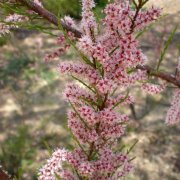Care of the plant Tamarix gallica or French tamarisk |
|
The genus Tamarix, family Tamaricaceae, includes about 60 species of trees and shrubs native to dry regions of Europe, Asia and Africa. Some species are: Tamarix gallica, Tamarix anglica, Tamarix chinensis, Tamarix aphylla, Tamarix africana, Tamarix boveana, Tamarix pentandra, Tamarix hispida. Common names: French tamarisk, Manna Plant, Salt cedar. This species is native to the Arabian Peninsula. They are deciduous trees or shrubs with long and flexible branches that reach 8 meters (26.24 feet) in height. The leaves are scaly and bluish-green in color. The numerous flowers are small and appear on white or pink cylindrical spikes. They bloom in spring and summer. French tamarisk is used as isolated specimens, next to ponds, in streets and public parks and to form small groups; it combines well with Vitex agnus-castus, Nerium oleander and Salix baylonica. It resists saline soils and saline wind: it's ideal for Mediterranean coastal gardens. Tamarix gallica needs a sunny exposure and a warm climate. Resists light frosts. Salt cedar prefers well-drained soils and does not grow well in limestone soils. Planting and transplanting are done in the fall or spring. Water the young plants abundantly once a week and the adult specimens every 10 days. French tamarisk resists drought well. Fertilize with manure in autumn and with mineral fertilizer in spring. Prune the branches that have blossomed lightly in autumn. Tamarix gallica is a plant resistant to the usual pests and diseases. French tamarisk is propagated by semi-woody cuttings in late summer and by woody cuttings in mid-autumn. |
Images of the plant Tamarix gallica or French tamarisk |
Find plants
Tamarix gallica or French tamarisk | Care and Growing
© 2025 FavThemes






